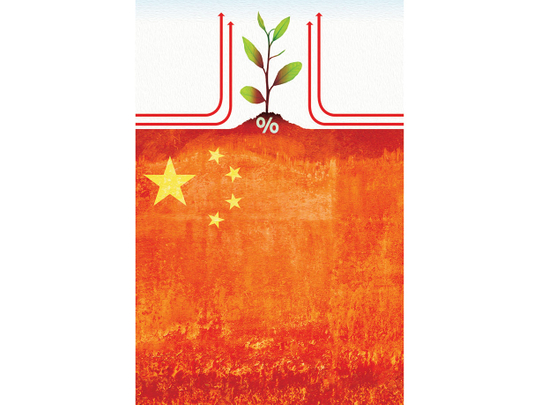
China’s recently finalised 13th five-year plan maps out its economic strategy and ambition for the 2016-20 period. Among its objectives are a doubling of GDP and average rural and urban household incomes relative to their 2010 levels.
These targets would require China’s economy to grow at an average annual rate of at least 6.5 per cent during the next five years. While this pace would be significantly slower than the 9.7 per cent growth the country has averaged since 1979, it is undeniably fast by international standards.
And, given that China’s growth has decelerated every quarter since the beginning of 2010, some have questioned whether it is achievable. I believe that it is.
Economic growth results from increases in labour productivity caused by technological advance and industrial upgrading. High-income countries, already on the cutting edge of productivity, must earn their increases through technological and organisational breakthroughs; as a result, their typical growth rate is about 3 per cent.
Developing countries, however, could potentially accelerate productivity growth, and thus GDP growth, by borrowing technology from advanced countries — that is, tapping the latecomers’ advantage, as China has done.
The question for China, after 36 years of catching up, is how much longer it can continue to benefit from this process. Some scholars believe it has reached its limits. Using historical data compiled by the economic historian Angus Maddison, they show how other East Asian countries experienced a deceleration of economic growth after their per capita GDP reached about $11,000 in purchasing-power-parity terms relative to constant 1990 US dollar prices, or $17,000 in constant 2005 US dollar prices.
For example, in the five years after Japan reached that level, its economy grew at an average annual rate of 3.6 per cent. In South Korea, growth fell to 4.8 per cent. In Hong Kong, it slowed to 5.8 per cent.
Given that China is projected to cross the same threshold sometime this year, many believe its average annual growth over the next five years will fall well below 7 per cent.
I disagree. What this analysis fails to take into account is the fact that advanced countries are not sitting by idly; they are growing and making technological breakthroughs. And that creates opportunities for developing countries to continue to learn.
Those who predict a slowdown in China are correct to look at its per capita GDP, which is a reflection of a country’s average labour productivity and thus the level of its technical and industrial advancement. But the best indicator of China’s growth potential is not its per capita GDP relative to some arbitrary threshold; it is the difference in per capita GDP between China and the US, the world’s most advanced economy. And on this measure, China has plenty of room for expansion.
When Japan crossed the $11,000 threshold in 1972, its per capita GDP was 72 per cent of the US level. When Taiwan crossed it in 1992, its per capita GDP was 48 per cent of America’s. The comparable figure for China today is only about 30 per cent.
In 2008 — the last year for which Maddison provided figures before he died in 2010 — China’s per capita GDP was 21 per cent of the US level. By examining how other East Asian economies performed when they were at a similar point compared to the US, we can estimate China’s potential for growth.
Japan’s per capita GDP was 21 per cent of America’s in 1951, and in the following 20 years it grew at an average rate of 9.2 per cent. In the two decades after Singapore hit that level in 1967, it grew at an average of 8.6 per cent. And the story is similar in Taiwan, Hong Kong, and South Korea; in the 20 years after their per capita GDP were 21 per cent of the US level, they grew at around 8 per cent.
There is no reason not to believe that China has the potential to do the same until 2018.
The Chinese economy’s current slowdown is the result of external and cyclical factors, not some natural limit. China has been suffering from the aftereffects of the 2008 financial crisis and plummeting export demand. From 1979 to 2013, annual export growth averaged 16.8 per cent. In 2014, it dropped to 6.1 per cent; in 2015, it dropped further, to -1.8 per cent.
This external drag is likely to continue, as politics in developed countries impedes efforts to implement the structural reforms — such as reducing wages, lowering social benefits, financial deleveraging, and consolidating budget deficits — needed to revive economic growth. Indeed, like Japan beginning in 1991, much of the developed world risks lost decades.
To achieve its growth targets, China will have to rely on domestic demand, including investment and consumption. Thankfully, it has strong prospects in both areas. Unlike developed countries, which often struggle to find productive investment opportunities, China can pursue improvements in infrastructure, urbanisation efforts, environmental management, and high-tech industries.
And, unlike many of its developing-country rivals, China has ample fiscal space, household savings, and foreign exchange reserves for such investments. The investments will generate jobs, household income, and consumption. As a result, even if external conditions do not improve, achieving 6.5 per cent and above annual growth is well within China’s reach. In that case, the country will continue to be the world’s primary economic engine, contributing about 30 per cent of global growth until at least 2020.
— Project Syndicate, 2016
The writer, a former chief economist and senior vice-president at the World Bank, is Professor and Honorary Dean of the National School of Development, Peking University, and the founding director of the China Center for Economic Research.












